IOS Lecture on “Aryans in India and Iran: A synthesis of linguistic, literary, archaeological, and genetic evidence”
February 18, 2019 in association with the department of history and culture, Jamia Millia Islamia, New Delhi

The Institute of Objective Studies, in association with the department of history and culture, Jamia Millia Islamia, organised a lecture on “Aryans in India and Iran: A synthesis of linguistic, literary, archaeological, and genetic evidence” at the department’s seminar room on February 18, 2019.
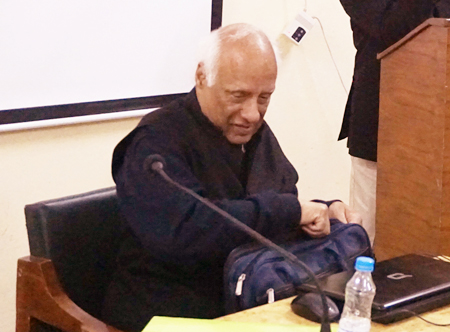
Professor Rajesh Kochhar, honorary professor at Punjab University, Chandigarh, who delivered the lecture, held that Indo-Iranians were members of the larger Indo-European group. Their languages were closer together than any others. This suggested that they stayed together the longest, and were the last to leave the steppes. He said that they were the only one in the PIE (Proto-Indo-European speakers) family who would produce literature: Rigveda (RV).
He raised certain questions, like when and where the RV was composed. Why RV and the Zoroastrian sacred book Avesta were so closely related. The question also arises if the Vedic people were related to the vast Harappan archaeological tradition. According to him, these quintessential questions have no direct answers. He noted that at current level of knowledge, archaeology and sacred texts constituted two distinct sequential streams which did not intersect. Referring to the Indian archaeology up to 2000, he said that the transition from food gathering, hunting and nomadism to farming of wheat and barley, animal breeding and settled life in north-west India began in the Neolithic era in 7000 BCE at Mehargarh in Baluchistan.
Mehargarh was situated at the foot of the Bolan pass on river Bolan, a western tributary of Indus. Agriculture diffused slowly out of Mehargarh. The Neolithic agricultural site of Kili Gul Muhammad, located barely three kms. north of the Quetta city was dated 4800 BCE. He observed that various technologies were introduced soon thereafter. Several mounds in the Mehargarh area showed continuous occupancy from 7000 till 2000 BCE. The Baluchistan phase was followed by the vast Harappan tradition so named after the first site discovered. The oldest site east of Baluchistan was Balakot, north-west of Karachi which was dated 4000-3500 BCE. The oldest site on Indus itself was Amri, where the earliest occupation was dated 3600-3300 BCE. These early sites marked the beginning of pre and early Harappan phases which led to the mature lasting from 2600-1900 BCE, and was characterized by major settlements such as Harappa, Mohenjo-Daro, Rakhigarhi and probably Ganjeriwala.
Commenting on Central Asian inhabitants, Prof. Kochhar said that presumably it was the quest for water which compelled Indo-Iranians to move southwards to areas where, thanks to rivers fed by the snow-clad pamirs and Hindu Kush, water shortage would not be so acute. A positive fallout of Russian occupation of Central Asia had been the thorough archaeological excavations in the area, including north Afghanistan. He said that it was unfortunate that south Afghanistan and Iran, which were more relevant from an Indian point of view, remained largely unexplored archaeologically. Archaeology of south Turkmenistan ran parallel to India’s with Namazgar V corresponding to urban centres of Harappa and Mohenjo-Daro.
In 2100 BCE, Namazgar V was ruined. Atop its ruins came up a small impoverished village, Namazgar VI, this showed clear signs of decline in material culture as well as new burial practices and new symbols. He observed that conclusive evidence of the migration of the Aryans came not from India or Iran, but from further west. A treaty (1400 BCE) concluded on cuneiform tablets between the victor Hittites and the defeated Mittanis (Aryans) mentioned the divinities Mitra, Varuna Indra and the (two) Nasatyas (Ashvini Kumars). He said that Soma/Haoma cult was common to the Rig-vedic/Avestan people. The Vedic agnisthoma and the Zorostrain Haoma ceremony were strikingly similar. The twigs were crushed, and the extracted juice, also called Soma, was filtered and drunk. RV, he pointed out, made it clear that Soma grew in mountains, a popular location being mount mujavat.
Regarding river Saraswati, Prof. Kochhar said that Saraswati was only river that was described in some detail in the old books of RV. It was aptly called Nadimata, the foremost of rivers. It rose in the mountains, cut its ridings, raised foam and went to the ocean. The Vinashana Saraswati had been identified with the present semi-defunct Ghaggar which lay between the Indus system in the west and Yamuna-Ganga in the east.
He said that unmindful of the Vedic references, the Puranas talked of Saraswati as an invisible river that joined Ganaga and Yamuna at Prayag. Europeans were not interested in the Puranas which they considered to be unworthy of note. They considered Vedic texts to be part of their heritage also. He said that the question of geographical identification of nadimata Saraswati was taken up for the first time by Europeans. Max Muller suggested the hypothesis that the Aryans came into India as invaders. He was severely criticised for this hypothesis. The question whether the Aryans came from outside or not would still remain open. However, it turned out that RV Saraswati was located outside India, it would conclusively prove that the Vedic people came into India from the outside.
Whether there was invasion or immigration was an emotional question, he added. He said that the mighty rivers Saraswati, Sarayu, Sapta Sindu, Gomti, which were mentioned in RV, were not connected with south Afghanistan where Indo-Aryans and Iranian-Aryans were stationed. The mystification of Saraswati river marked the end of the Rigvedic era and the beginning of a new one, characterised by the use of iron and the shifting of Vedic scholarship into the hands of people who were not connected with the composition of RV.
Prof. Kochhar explained that if rigorous study of ancient Indian history was to advance, it must be provided with direct evidence rather than circumstantial. It might not be advisable to embark on archaeological exploration of south Afghanistan, but a rigorous, open ended, multi-nation investigation into the hydrological history of Ghagghar river system would be valuable. He said that the studies of ancient DNA were new powerful tools in the hands of historians and archaeologists. These studies could help historians choose among competing hypotheses. The extent of the actual population of Indo-Iranian speakers that ended up in Iran, Afghanistan, and north-west India at current level of knowledge, and in the absence of direct proof, one could only propose hypotheses. The absence of direct proof in fact tended to support the hypothesis that most of RV was composed in south Afghanistan rather than north-west India, he concluded.
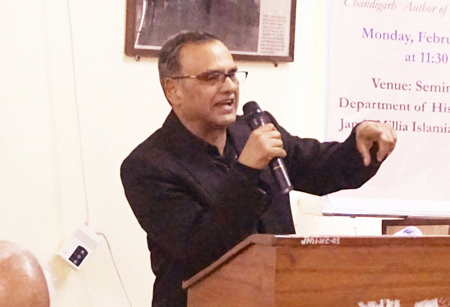
In his presidential remarks, Prof. R P Bahuguna, professor of history, and director, centre for distance and open learning, Jamia Millia Islamia held that all religions developed by way of the absorption of some elements from other religions. Referring to the religion of a person, he quoted an ex-judge of the Kerala High Court as saying that “one was a Hindu if he said he was a Hindu”. He said that Prof. Kochhar clarified certain points on which opinion among historians was divided. He pointed out that Aryans were not the ethnic people. He asked researchers to be very careful while using the term Aryan. Describing the migration of Aryans to India as greatest, he said that it affected everyone demographically. Later also migration took place, but the scale was not that large, he noted.
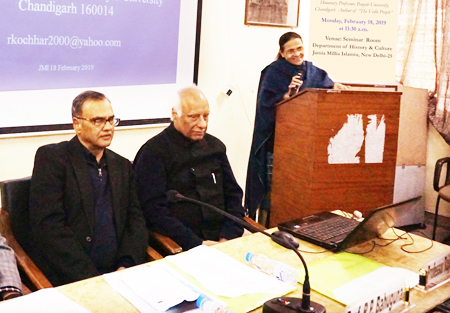
Earlier, Prof. Nishat Manzar, head of the deptt. of history and culture, Jamia Millia Islamia, welcomed the guests and said that the lecture would focus on the origin of Aryans. Prof. Syed Jamaluddin, ex-professor of history, Jamia Millia Islamia, and the director, Historical Research Projects, IOS, introduced the subject and briefly explained the mandate of the project. He said that of late, Indian history from the ancient times to the post-Independence period was being sought to be re-written by historians owing allegiance to the Hindutva ideology. Their sole purpose was to give a short shrift to objectivity and facts. They based their theses on fancy and unauthenticated facts, he observed.
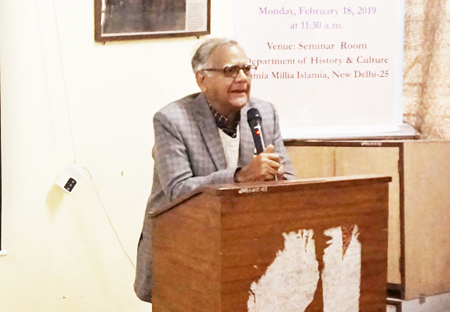
Secretary General, IOS, Prof. ZM Khan, gave an account of the activities of the Institute. While Prof. Syed Jamaluddin conducted the proceedings, Prof. Haseena Hashia, asstt. secretary general, IOS, extended a vote of thanks. The lecture was attended by university teachers, researchers and students of the history deptt. oaf Jamia Millia Islamia.
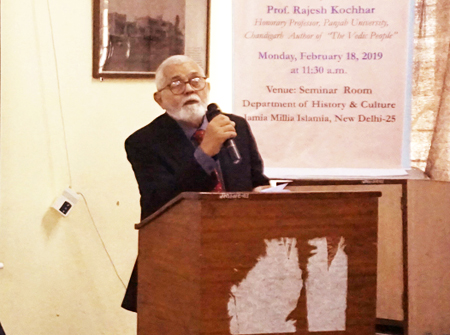
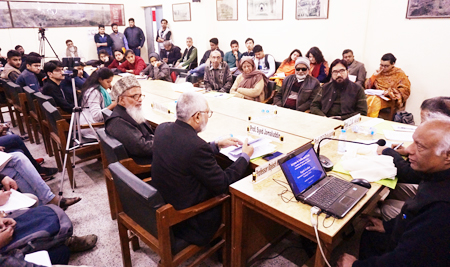
|